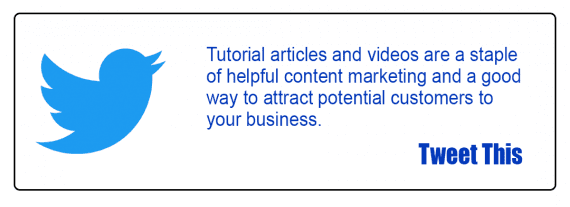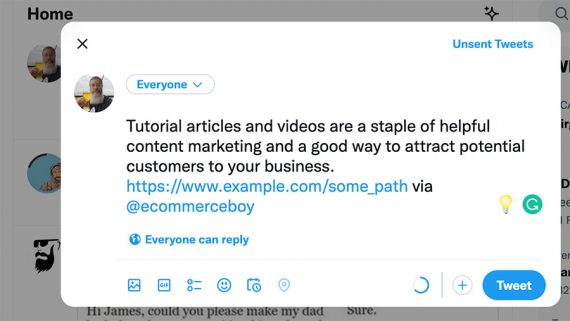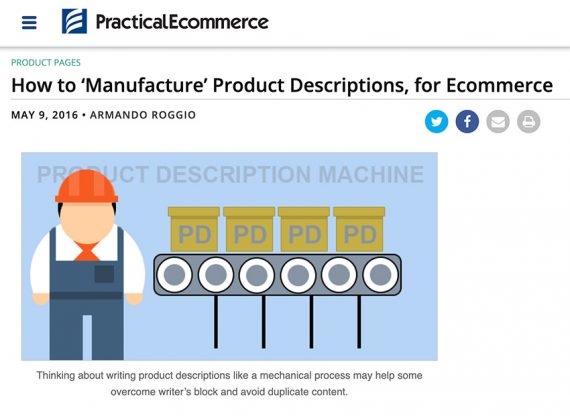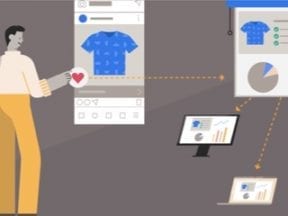Tutorials are a staple of content marketing and an effective way to attract potential customers. In general, a tutorial is a teaching method dependent on examples. It shows the discrete steps to complete a task.
In marketing, tutorials are a form of “help” content — especially within a Hero-Hub-Help framework. They can create a sense of reciprocity, wherein the person using the tutorial feels obligated to your brand because of the helpful information you shared. Additionally, tutorials are beneficial for search engine optimization.
Tutorial Characteristics
Tutorials ought to be concise, understandable, and repeatable. Your audience should be able to follow the steps to achieve a predictable outcome, such as the completion of the task.
Sometimes this will be specific and prescriptive. For instance: how to make lasagna. Or it could be more general, such as this article: a tutorial about creating tutorials.
Tutorial Structure
While acknowledging a range of possible tutorial outlines, we can identify three fundamental parts typical to any decent tutorial, including:
- Description of the task or problem,
- Overview of the explanation,
- Demonstration of how to complete the job.
Consider a short example: how to create a “Tweet This” link to share an article on Twitter.

A “Tweet This” link makes it easy for a reader to share content on Twitter.
Description. We will start by describing the task: How to make content easy to share on Twitter.
Create a “Tweet This” link to allow readers to share your content on Twitter and amplify your content’s reach.
Overview. Next, provide an overview of the explanation.
A “Tweet This” link is an encoded URL that includes the content to be shared, the associated web address, and a Twitter handle. The link consists of four parts you can easily write.
Demonstration. Finally, demonstrate the process.
1. The “Tweet This” link starts with a Twitter URL.
http://twitter.com/share?
This link points to Twitter and tells the social media platform something is about to be shared. The “?” indicates that parameters follow — the source URL, content, and the source’s Twitter handle.
2. Add the web address for the source prefaced with the parameter “URL” and an equal (=) sign.
url=https://www.example.com/some_path
3. Include the encoded text. Here “encoded” means special characters, such as spaces, replace a series of standard symbols to make it easier for servers to parse the content. For example, a space replaces the %20.
To help with encoding the text, you can use an online tool such as Eric Meyer’s free URL encoder or manually encode the copy using an encoding reference like W3 School’s ASCII.
In the “Tweet This” link, the content to be shared is prefaced with an ampersand (&) to add it to the URL string, the parameter “text,” and an equal sign (=).
&text=Tutorial%20articles%20and%20videos%20are%20a%20staple%20of%20helpful%20content%20marketing%20and%20a%20good%20way%20to%20attract%20potential%20customers%20to%20your%20business
4. Give credit to the source’s Twitter handle, which may help to grow a Twitter following. Similar to the “text” parameter described in the last step, this portion of the link started with an ampersand (&) to concatenate this new section; a parameter name, “via” in this case; and an equal sign (=) followed by the parameter’s value.
&via=ecommerceboy
The resulting link will open a tweet editor on Twitter.

In a tutorial, show examples of the steps and conclude with the finished task.
Example Tutorial
The above “Tweet This” tutorial represents the process of creating your own tutorial. Now let’s look at a favorite tutorial article, “How to ‘Manufacture’ Product Descriptions, for Ecommerce,” and identify these sections.

This tutorial example includes the three fundamental sections: description, overview, and demonstration.
Describe the task. First, let’s consider how the article describes writing ecommerce product descriptions.
Writing product descriptions can be one of the most significant challenges ecommerce businesses face. Some entrepreneurs or managers might not be comfortable with writing. What do you say about a pair of shoes, a fishing reel, or something like a hammer or a screw?…
To make matters worse, a poor product description could hurt your ecommerce business. The harm can be done in a couple of ways.
First, a poor, bland product description may not inspire a shopper to buy or give him enough information to make a good buying decision.
Second, if you copy a manufacturer’s product description, your page or even your site may not perform well in search engines. At the time of writing, Google does not penalize sites for duplicate content unless it believes duplication was used to be deceptive. Nonetheless, when faced with duplicate product content across several ecommerce sites, Google may pick just one site to show in its search results.
This tutorial article explains the task at stake. It should be apparent to the reader that product descriptions are essential.
Overview of the explanation. Next, the article explains how to solve the product description writing task.
Given the problem of what to write (a form of writer’s block) and the danger of publishing poor product descriptions (lower conversions or duplicate content), some online stores may want to take a mechanical approach to building (writing) product descriptions.
The idea is simple. Rather than sitting down at a keyboard, staring at a picture of your product, or trying to rewrite the manufacturer’s description, follow a process.
Demonstrate how to complete the task. The product description tutorial article describes a seven-step process — two of which it calls optional — for consistently manufacturing good ecommerce product descriptions.
At each step of the process, the article provides an example product description, specifically for a soup spoon.
After step one, “Focus on a Single Thing,” the spoon description is a single line.
This soup spoon has a large bowl.
By the end of step three, “Clarify and Specify,” the spoon description is beginning to take shape.
This soup spoon has a large bowl. In fact, this soup spoon can hold about three times as much soup as your standard table spoon. So you get more soup with each bite.
The final product description has grown significantly right before the reader’s eyes.
Hungry for some hearty chicken noodle soup or creamy clam chowder? This soup spoon has a large bowl to haul bisques and broths to your mouth. In fact, this soup spoon can hold about three times as much soupy goodness as your standard table spoon. You could take three times as many bites or buy this soup spoon and slurp large.
Beyond Helping Customers
Tutorials like this one are a key type of content, whether the purpose is journalism or marketing. When your business creates tutorials, you are not just helping customers. You are providing a marketing tool that attracts prospects and introduces them to your business.




